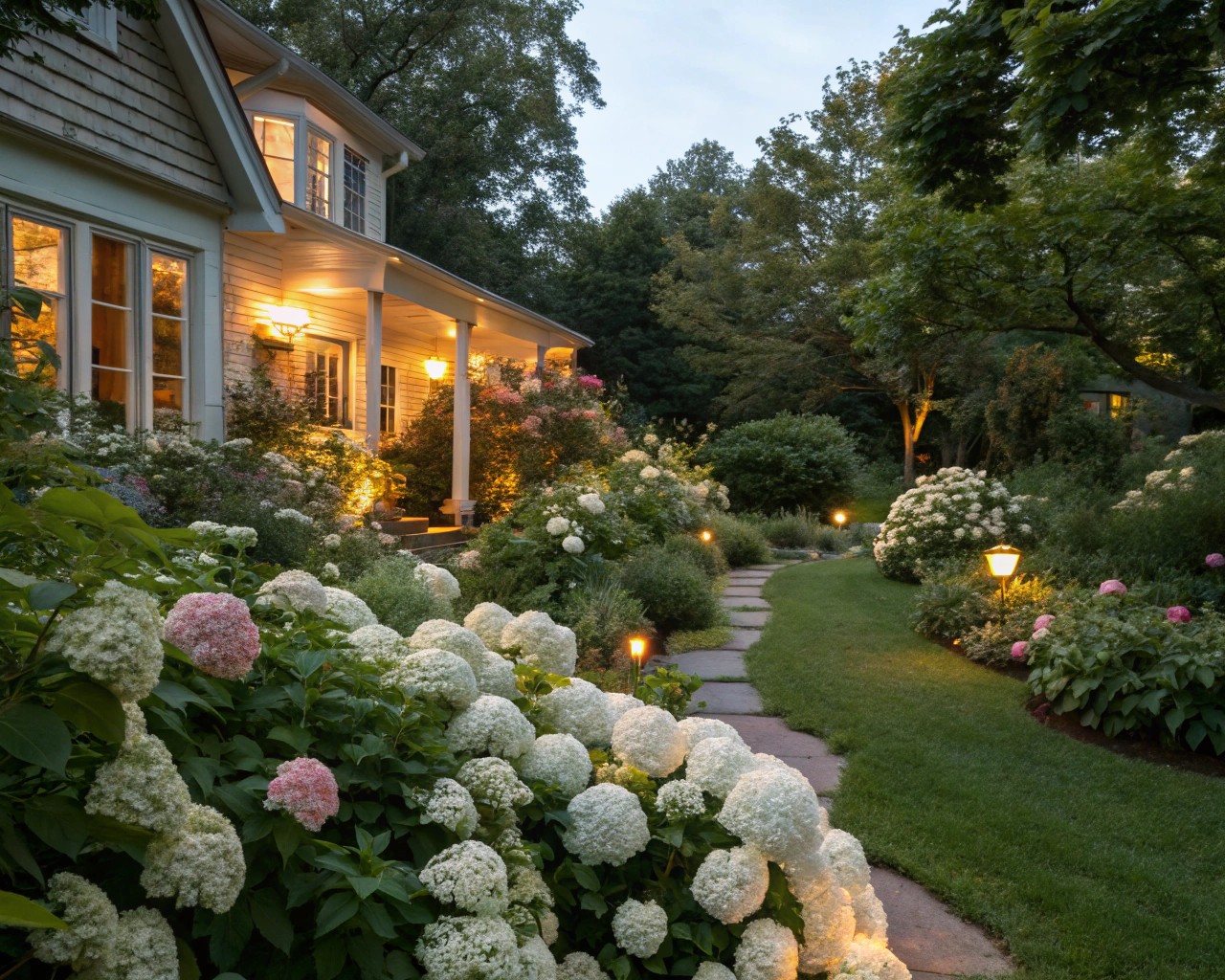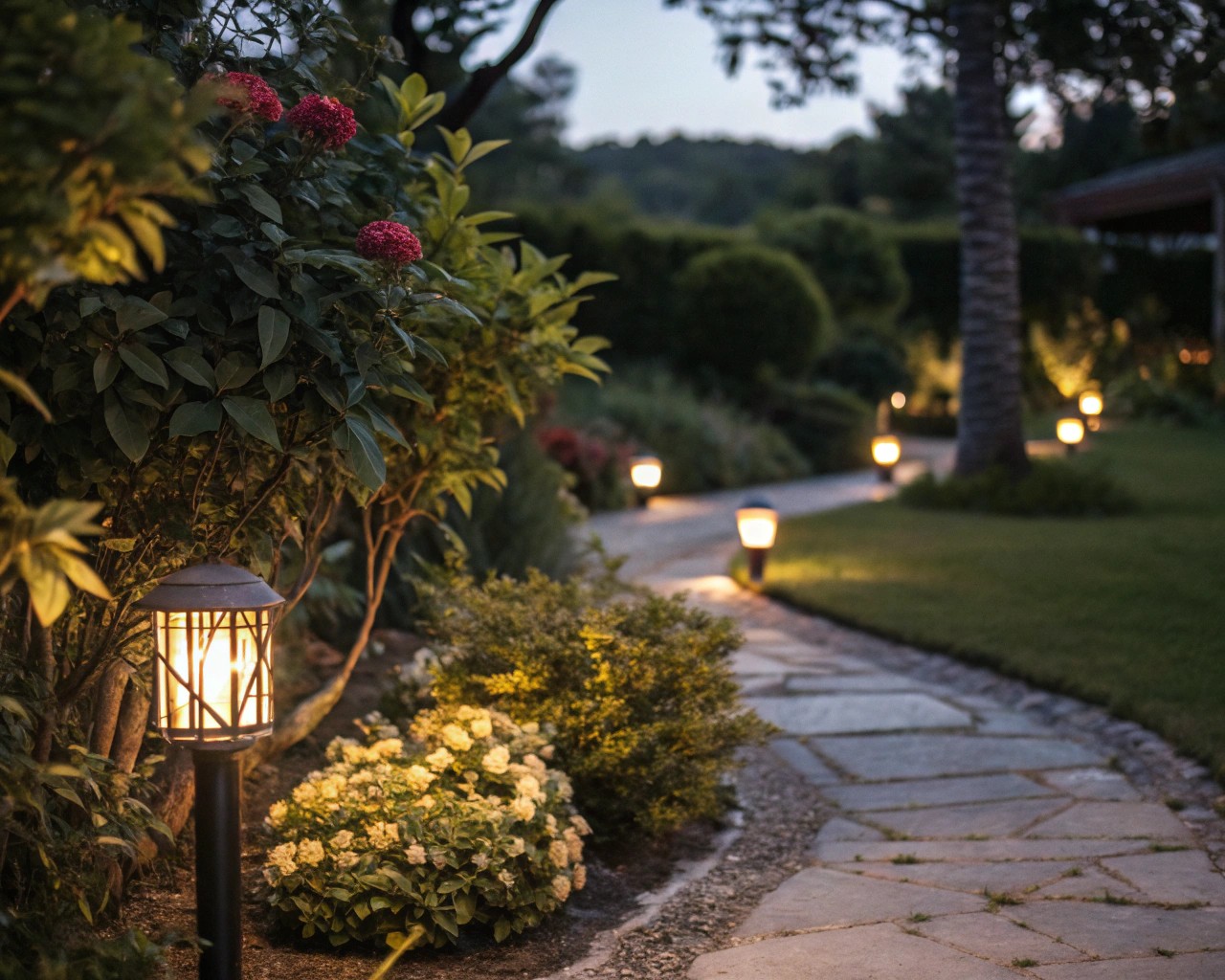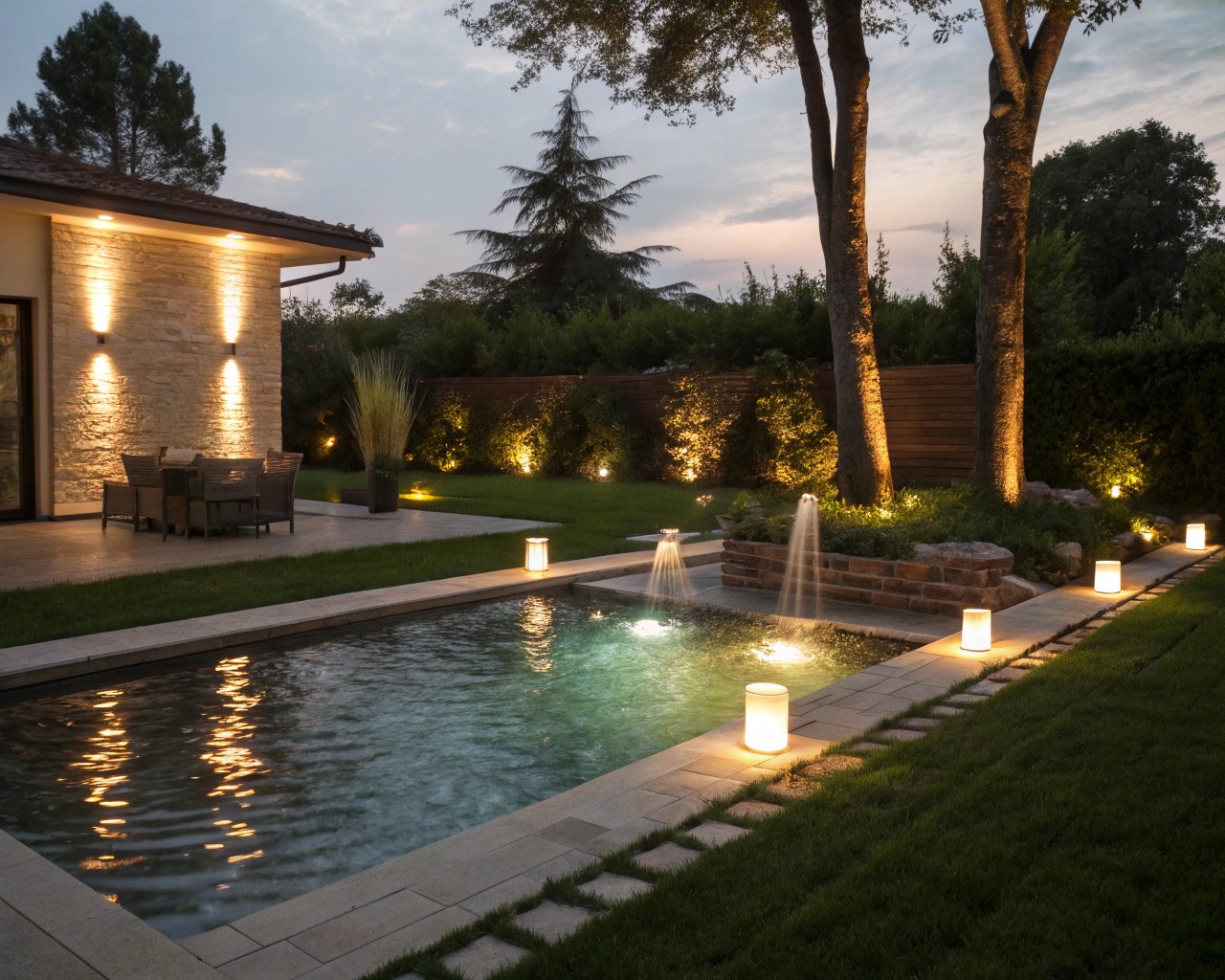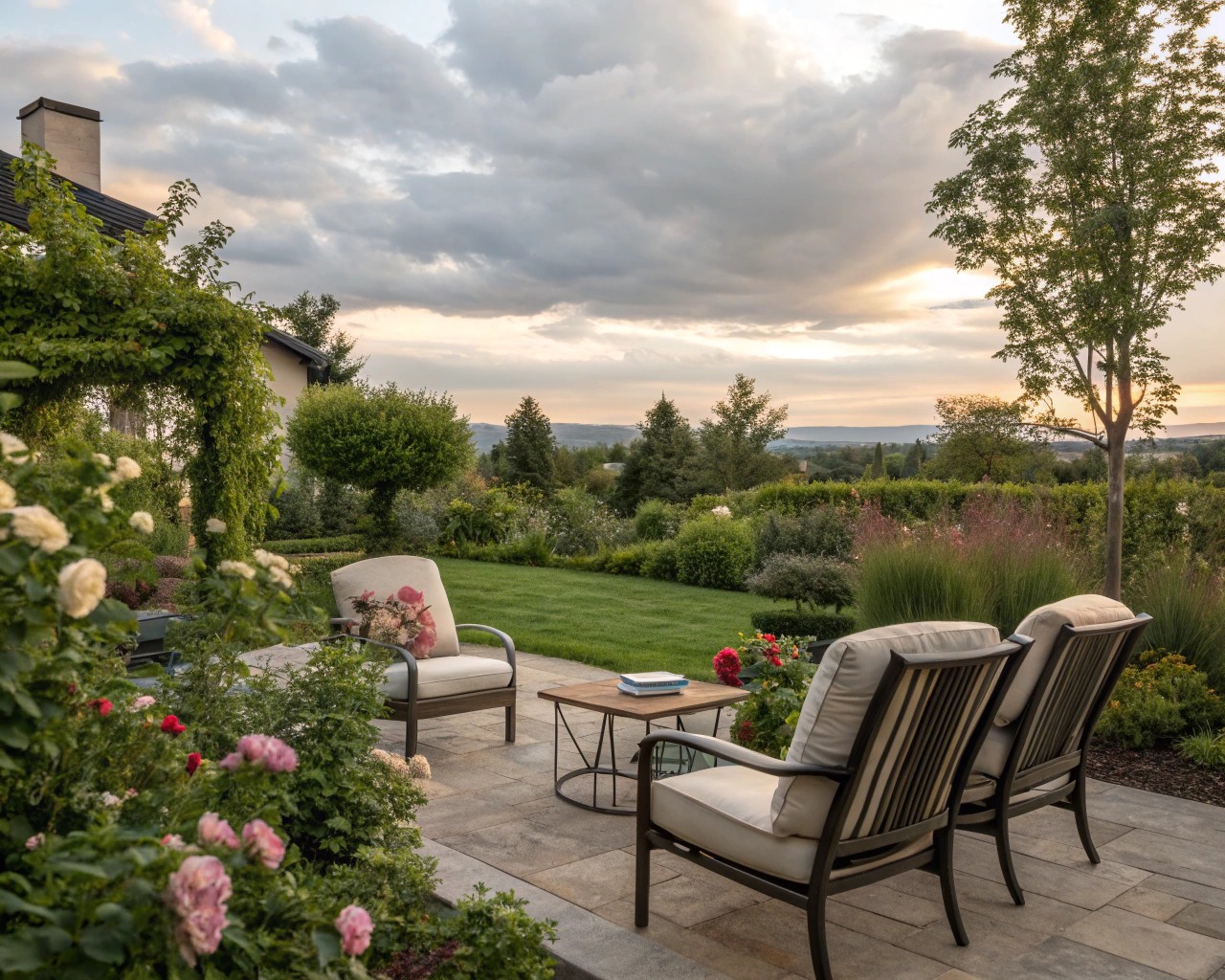After a long workday, there’s something magical about stepping into a garden designed specifically for evening enjoyment. Creating spaces that welcome you home and extend your outdoor time well past sunset requires thoughtful planning with light, scent, and functionality in mind. I’ve spent years helping clients transform ordinary backyards into evening sanctuaries where they can decompress, entertain, and reconnect with nature as day transitions to night.
Understanding Evening Light and Garden Magic

The garden transforms dramatically as daylight fades. Early evening sunlight casts a golden glow that highlights plants in warm tones, while later, only the palest elements remain visible. This natural light transition creates opportunities for a thoughtfully designed space.
As one garden designer noted, light truly changes everything. The setting sun can backlight delicate foliage like fountain grass, making it seem to glow. As dusk deepens, plants with white or variegated leaves stand out, remaining visible much later into the evening.
When designing evening gardens, we must consider how each area receives light throughout sunset and into nighttime. This awareness helps position plants and features to maximize their evening appeal and extend enjoyment of your outdoor space.
The Psychology of Evening Gardens
Evening gardens serve as transitional spaces between work and home life—a decompression chamber of sorts. Designers suggest envisioning the evening ritual of lingering outdoors as a transformative way to reconnect with the natural world. With appropriate plantings, thoughtful design, and comfortable furnishings, your own backyard can become a haven for evening restoration.
You can view your after-hours garden as a place for personal time that commemorates the end of workday while celebrating connections with nature. Just as you’d design any party venue with festivities in mind, choose plants and ornaments that contribute to this evening celebration.
Essential Elements for Evening Garden Success
Selecting Plants That Shine After Sunset

The most successful evening gardens incorporate plants that remain visually appealing as daylight diminishes. Here’s what to consider:
Light-Colored Blooms and Foliage
“White remains the most perceptible color from evening into night, so strategically place variegated plants and those with white flowers where they’ll be visible as the sun goes down”. In larger gardens, remember that bigger flowers will be more striking than tiny ones when viewed from a distance in the evening.
Some excellent choices include:
- Clematis ‘Maria Cornelia’ – pale flowers that appear to float in darkness
- Gaura lindheimeri ‘The Bride’ – clouds of white flowers
- Hosta ‘El Niño Green’ – light-colored foliage
- Artemisia ‘Powis Castle’ – silvery foliage reflects moonlight
- Petunia ‘Surfinia Lime’ – pale flowers visible in low light
Evening-Scented Plants
Many plants release their strongest scents at dusk to attract night-flying pollinators. Placing scented plants along paths or near benches adds another sensory dimension to the garden experience. Their fragrance becomes particularly noticeable in smaller spaces or when several scented varieties are combined.
I’ve found that positioning these fragrant varieties near seating areas maximizes their impact. Plant them in sheltered locations that receive ample daytime sun—the accumulated heat helps release their perfume as evening approaches.
Top Evening-Scented Plants:
| Plant | Fragrance Profile | Best Location |
|---|---|---|
| Honeysuckle | Sweet, intoxicating | Walls, pergolas, trellises |
| Night phlox | Spicy vanilla | Border edges, containers |
| Jasmine | Intensely sweet | Near windows, patios |
| Nicotiana | Tobacco-like sweetness | Containers, bed borders |
| Evening primrose | Subtle, lemony | Ground cover, borders |
| Moonflower | Tropical, vanilla | Vertical spaces, trellises |
Long-Season Performers
Especially in smaller gardens where space is precious, it’s wise to avoid plants that offer only brief interest. Instead, focus on varieties with extended flowering seasons. Look for options like repeat-flowering roses, Erigeron karvinskianus, Erysimum ‘Bowles’s Mauve’, and hardy geraniums that provide visual appeal for many months.
Illuminating Your Evening Oasis

Strategic lighting transforms an ordinary garden into a magical nighttime retreat. One project I worked on featured “ambient lighting designed to sensitively illuminate each garden ‘zone’ – entertaining, eating, firepit and hot-tub – enabling enjoyment well into the evenings”.
Lighting Techniques for Evening Gardens
Different lighting approaches create various effects:
- Uplighting: Positioning lights at ground level to shine upward, highlighting trees or features
- Path lighting: Small fixtures that guide movement through the garden safely
- Moonlighting: Lights placed high in trees to mimic moonlight filtering through branches
- Feature lighting: Highlighting specific garden elements like water features or sculptures
Small shrub lights can effectively illuminate plantings and cast appealing shadows across borders. Uplighting techniques allow dappled light to filter through foliage, creating attractive patterns where the mix of greens complements the natural hues of wood and stone.
Sustainable Lighting Solutions
For environmentally conscious evening gardens, consider:
- Solar lighting – Harnesses daylight for evening illumination
- LED systems – Energy-efficient and long-lasting
- Smart controls – Some systems allow all garden lighting to be controlled remotely via tablet or phone, minimizing energy waste
- DIY options – “Homemade options include tin can lanterns and glass jar lanterns”
Creating Functional Evening Spaces
Zones for Different Activities
Successful evening gardens typically include multiple areas designed for specific activities:
- Relaxation zones with comfortable seating positioned to enjoy sunset views
- Entertainment areas for gathering with friends and family
- Dining spaces with adequate task lighting for food preparation and eating
- Transition pathways that guide movement through the garden after dark
One client explained their needs clearly: “Most of all the client wanted first of all a useable garden. One that felt bigger than it is, looked bigger than it is and where every square centimetre of space works hard”.
Water Features for Evening Ambiance

Water elements add multiple dimensions to evening gardens:
- Sound masking – In one instance, “The client’s requirements for the project included a water feature to minimize the noise of the freeway”
- Reflective qualities – Surfaces that capture and amplify lighting effects
- Cooling properties – Creating comfortable microclimates on warm evenings
- Visual interest – Dynamic movement in otherwise still evening scenes
For one memorable project, we installed a “basalt columns water feature chosen for its natural appearance which blends with other features of the home and landscape. Landscape lighting brings this to life late into the evening and it can be viewed from multiple windows in the home”.
Comfortable Evening Seating

Seating options should invite lingering as day transitions to night:
- Arrange seating to capitalize on sunset views
- Consider convertible furniture that adapts as temperature changes
- Include side tables for drinks and small plates
- Position seating near evening-scented plants for maximum enjoyment
Imagine a private front yard oasis just steps from the street, offering a cool haven for relaxation. This effect can be achieved with elements like bright apple-green Adirondack chairs, coordinating decorative pillows, a striking teal container, and chartreuse-foliaged plants providing vibrant pops of color against the evening light.
Case Studies in Evening Garden Transformation
From Mismatched to Cohesive: A Garden Reborn
One client approached me with what they described as a “mismatched” garden lacking cohesion. Their evening enjoyment was limited by poor planning and disconnected elements.
As the client shared, “Carol took my ‘mismatched’ garden and pulled it together by incorporating a variety of plants which added interesting leaf shapes, texture, and color. With the addition of stone paths and walls, art pieces, and a deck with planter boxes, she created a garden that blends continuity, interest, and beauty”.
The transformation focused on:
- Removing plants that no longer served the overall design
- Adding variety with interesting textures visible in low light
- Creating a deck that functions as an outdoor living room
- Using planters instead of railings to integrate garden elements
The client found that “The new deck feels more like an outdoor living room and is an extension of the great room. What had been a dark interior room now feels significantly bigger and airy”.
The 30-Year Dream Garden
Perhaps my most meaningful project involved fulfilling a client’s tribute to his late wife. “This project started off as a dream of the client’s late wife. For years she had wanted to transform their backyard into a retreat. After her passing our client felt a pressing need to bring this 30-year dream to life in memory of her”.
The challenges were significant:
- Major drainage and erosion issues
- Decaying timber walls becoming dangerous
- No safe access to lower garden levels
- Noise intrusion from a nearby freeway
Our solution included:
- Fieldstone walls to terrace the landscape and solve erosion
- Lannon stone steps for safe level transitions
- A basalt column water feature to mask highway noise
- Integrated landscape lighting for evening enjoyment
- A strategically positioned hammock for relaxation
“A hammock was added to this project so the client could enjoy afternoon naps and catch up on some reading. It is the perfect location to enjoy the entire back yard while listening to the sound of water cascading down the centerpiece of this landscape”.
Asymmetrical Space Transformed
Another challenging project involved working with an asymmetrical back garden where a garage and driveway created an awkward L-shaped space. Before our intervention, the garden offered very little functional space for seating or entertaining; although the planting was attractive, the layout didn’t encourage anyone to step outside and explore.
We addressed multiple issues:
- Poor drainage that left the lawn waterlogged (“like porridge”) in winter
- Sour soil from construction impact
- Excessive sunlight through living room windows
- Narrow, rarely used sections of the garden
The solution centered on improving the connection between the house and garden, recognizing that strong indoor-outdoor flow is crucial for encouraging people to actually use and enjoy their gardens. A new, larger patio capable of accommodating outdoor dining replaced a previously existing narrow plant border that had visually cut the patio off from the main garden area.
Practical Evening Garden Design Tips
Evaluating Your Space for Evening Potential
Before beginning your evening garden transformation, carefully assess:
- Light patterns: Notice which areas receive the last rays of sunset
- Existing views: Identify what you want to highlight and what you’d rather screen
- Functional needs: Consider how you’ll actually use the space after work
- Privacy concerns: Determine what’s visible to neighbors in evening light
It’s essential to evaluate the light conditions in your yard. Determine whether areas receive full sun, partial sun, or are shaded by a dense canopy. This understanding of light levels dictates how the space can best be used and which plants are likely to thrive.
Budget-Friendly Evening Garden Ideas
Not every evening garden requires extensive renovation:
- Refresh existing spaces with strategic lighting
- Add container plantings with evening-friendly plants
- Incorporate affordable DIY elements like candle lanterns and solar fairy lights
- Repurpose existing furniture with light-colored cushions visible in low light
Planning for Year-Round Evening Enjoyment
A truly successful evening garden provides enjoyment across multiple seasons:
- Spring: Early bloomers that extend enjoyment as days lengthen
- Summer: Peak evening garden season with longest daylight hours
- Fall: Late-blooming plants and glowing foliage
- Winter: Structural elements highlighted with strategic lighting
For maximum impact, especially where space is limited, consider choosing smaller trees that offer multi-season interest. For example, the spring-flowering Amelanchier lamarkii also provides black berries in summer and attractive autumn leaf color, extending its value throughout the year.
Creating Multi-Sensory Evening Experiences
Beyond Visual Appeal
While sight dominates garden design discussions, evening gardens particularly benefit from engaging all senses:
Scent: Including plants with evening fragrance is key. Many varieties release their scent at dusk, often to attract the night-flying moths that pollinate them. This fragrance is usually most potent in warm, still air.
Sound: Water features provide “the soothing sound of moving water” while grasses offer subtle rustling in evening breezes.
Touch: Incorporate textured materials that can be appreciated even in low light—smooth stones, velvety leaves, rough bark.
Taste: “Don’t forget about all the entertaining you’ll be doing this summer. Grow herbs that will not only give a lovely aroma to your evening garden but can also be a delicious addition to your cocktails and your cooking”.
One garden designer described their approach as creating a “choreographed, Technicolor experience [that] is sensory and sensual, refreshing your mind and spirit. It’s a place to both find and lose yourself”.

